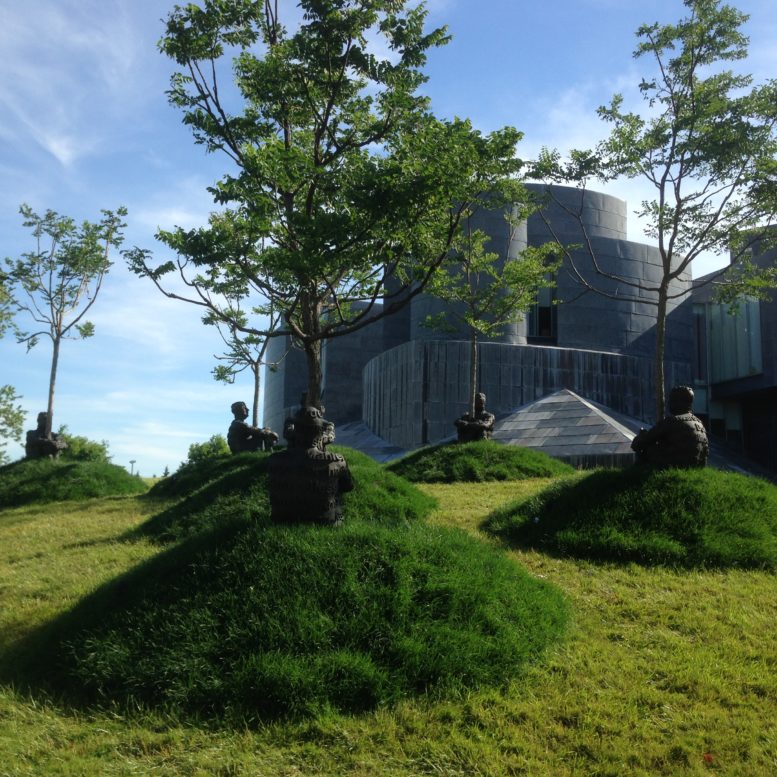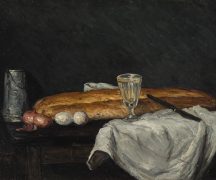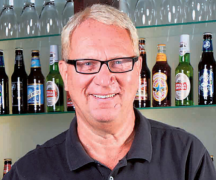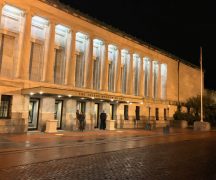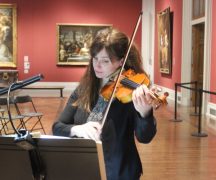By DAVID DUPONT
BG Independent News
For sculptor Jaume Plensa, the placement of one of his sculptures is as important as the work itself.
That’s especially true of his outdoor works. Still he described his visit to Toledo to consult about where to situate the work on the grounds of Toledo Museum of Art almost as a play date. He walked around with a few friends and two gardeners carrying flags. “I loved those guys with the flags.”
Amy Gilman, the museum’s associate director and one of those in the group, asked him Thursday night why he decided to place one work, “The Heart of Trees,” up on a hill, instead of on the flat, where the museum had suggested. The world renowned artist said: “A kid loves to change things. If you say ‘down,’ then I say ‘up,’ and it’s not more complicated than that.”
“You know my son,” Gilman quipped.

Sculptor Jaume Plensa and Amy Gilman, associate director of the Toledo Museum of Art, in conversation in the Peristyle Thursday (June 23).
The exchange was part of a public conversation held Thursday at the museum as part of the ongoing exhibit Jaume Plensa: Human Landscape, which continues outdoors and in the Levis Galleries through Nov. 6.
In his introduction, Museum Director Brian Kennedy called Plensa “a most distinguished art practitioner in our world today.”
“A very significant part of Jaume’s practice is public sculpture, creating moments for public engagement,” he said. Plensa’s work is on display around the world, including “the most extraordinary work he’s made,” the Crown Fountain in Chicago’s Millennium Park.
Plena said, in placing a work: “You are not thinking about the object in itself but what energy this object is spreading about. … The space is much more important than the work itself.”
That was demonstrated in the siting not only of the Human Landscape works but in “Speigel (Mirror)” which sits on the edge of the museum’s 36-acre campus.
When Plensa visited to consult on the installation in 2012, he made “important adjustments” to the initial site, Gilman said.
She and exhibit designer Claude Fixler had originally envisioned placing “Speigel” on a small rise. But the artist wanted it brought down closer to the street.
“I have a certain utopian idea of what is art’s relationship to society,” Plensa explained on Thursday. “I think art should go to them and embrace the community.”
On the hillock, “Speigel” was “in a certain way protected.” He knew museum officials saw the sculpture as a bridge to the surrounding neighborhood and the city. So he brought it down “at the same level as our human beings,” he said. He wanted residents to say: “This is mine. That belongs to me. That piece is ours. It is part of the community, so I should really respect that piece. I should love this piece. I should live with it.”
It has, Gilman said at a press conference last week, become one of the museum’s most beloved works.
Plensa said that the way his work is appreciated, even loved, by people around the world “for me is a mystery.”
“I’m from a specific culture,” he said. The artist, who like Picasso is from Catalonia in Spain, “grew up in a specific geographic area.”
Why people can final this common ground in a work of art, he said, is “the most beautiful accident we can get.”
But it’s not because he’s trying to make a universal statement.
“My understanding is the deeper you go inside yourself, the closer that you’re going to the audience,” he said. “It seems like a contradiction.” But “when you try to go deep inside yourself” exploring the origins of the artistic impulse and ask ‘’who am I?’ You are asking others the same question.”

Detail, “The Heart of Trees”
Plensa said that “The Heart of Trees,” which he moved to higher ground, is a self-portrait. The work is a group of seven bronze figures each embracing a Kentucky coffee tree. The idea, he said, is rooted in the dream of a medieval alchemist who had a vision of what happens when someone dies. “From a dead body, a new life is coming out and that new life is in the shape of a tree,” Plensa said. “It’s a very romantic idea.”
This tree represents the person’s spirit and “in these branches we will all be together again.”
The names of Plensa’s favorite composers are embossed on the figures.
He recalled as a child hiding inside the cabinet of the piano while his father played. “I remember the vibration, the smell of the piano. It makes me approach the music in a more biological way, not intellectual way,” he said. “For me, music was the perfection of the universe. … I am trying all my life to express that in my work.”
His art also reflects his love of the written word. Almost all his pieces employ letters in some form. He employs alphabets from many languages, sometimes to form words, sometimes simply for their intriguing designs.
In the museum’s Levis Gallery, he has strung lines from his favorite poets spelled out in metal letters. They create a series of screens like those he remembers in the grocery stores when he was young. Those screens were meant to keep the bugs out. In this case, Plena said, “poetry is protecting us.”
Yet he’s not sure offers protection. “The more we know the more fragile we are,” Plensa said. Many years ago he created piece in which he said “poetry seriously damages your health.”
“When you find an amazing text, an amazing poem,” Plensa said. “When you listen to an amazing piece of music. Something that’s so moving, you feel more fragile.”
For him, “sculpture is completely related to your body. It’s a container you have to breathe a soul into. The importance is what is inside.”
Each piece, he said, is a fragment of something larger.
“Paula,” the 22-foot tall bronze figure overlooking Monroe Street, “is part of family of works, a work in progress.”
“One piece is part of another and another and another,” he said. “It’s like a network, an extension. Those pieces are facing one another. But some of those pieces are facing my studio, and nobody realizes. And some of those pieces are facing Toledo.”
Parts of that artistic web are in place all around the world.
“I love to imagine if I had the capacity, and I could go farther and look from above: That’s my work. That’s the totality, not one or the other. One day that would be the image of myself.”

